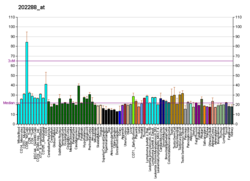Subsequent history
The discovery of TOR and mTOR stemmed from independent studies of the natural product rapamycin by Joseph Heitman, Rao Movva, and Michael N. Hall in 1991; [16] by David M. Sabatini, Hediye Erdjument-Bromage, Mary Lui, Paul Tempst, and Solomon H. Snyder in 1994; [11] and by Candace J. Sabers, Mary M. Martin, Gregory J. Brunn, Josie M. Williams, Francis J. Dumont, Gregory Wiederrecht, and Robert T. Abraham in 1995. [12] In 1991, working in yeast, Hall and colleagues identified the TOR1 and TOR2 genes. [16] In 1993, Robert Cafferkey, George Livi, and colleagues, and Jeannette Kunz, Michael N. Hall, and colleagues independently cloned genes that mediate the toxicity of rapamycin in fungi, known as the TOR/DRR genes. [17] [18]
Rapamycin arrests fungal activity at the G1 phase of the cell cycle. In mammals, it suppresses the immune system by blocking the G1 to S phase transition in T-lymphocytes. [19] Thus, it is used as an immunosuppressant following organ transplantation. [20] Interest in rapamycin was renewed following the discovery of the structurally related immunosuppressive natural product FK506 (later called Tacrolimus) in 1987. In 1989–90, FK506 and rapamycin were determined to inhibit T-cell receptor (TCR) and IL-2 receptor signaling pathways, respectively. [21] [22] The two natural products were used to discover the FK506- and rapamycin-binding proteins, including FKBP12, and to provide evidence that FKBP12–FK506 and FKBP12–rapamycin might act through gain-of-function mechanisms that target distinct cellular functions. These investigations included key studies by Francis Dumont and Nolan Sigal at Merck contributing to show that FK506 and rapamycin behave as reciprocal antagonists. [23] [24] These studies implicated FKBP12 as a possible target of rapamycin, but suggested that the complex might interact with another element of the mechanistic cascade. [25] [26]
In 1991, calcineurin was identified as the target of FKBP12-FK506. [27] That of FKBP12-rapamycin remained mysterious until genetic and molecular studies in yeast established FKBP12 as the target of rapamycin, and implicated TOR1 and TOR2 as the targets of FKBP12-rapamycin in 1991 and 1993, [16] [28] followed by studies in 1994 when several groups, working independently, discovered the mTOR kinase as its direct target in mammalian tissues. [10] [11] [20] Sequence analysis of mTOR revealed it to be the direct ortholog of proteins encoded by the yeast target of rapamycin 1 and 2 (TOR1 and TOR2) genes, which Joseph Heitman, Rao Movva, and Michael N. Hall had identified in August 1991 and May 1993. Independently, George Livi and colleagues later reported the same genes, which they called dominant rapamycin resistance 1 and 2 (DRR1 and DRR2), in studies published in October 1993.
The protein, now called mTOR, was originally named FRAP by Stuart L. Schreiber and RAFT1 by David M. Sabatini; [10] [11] FRAP1 was used as its official gene symbol in humans. Because of these different names, mTOR, which had been first used by Robert T. Abraham, [10] was increasingly adopted by the community of scientists working on the mTOR pathway to refer to the protein and in homage to the original discovery of the TOR protein in yeast that was named TOR, the Target of Rapamycin, by Joe Heitman, Rao Movva, and Mike Hall. TOR was originally discovered at the Biozentrum and Sandoz Pharmaceuticals in 1991 in Basel, Switzerland, and the name TOR pays further homage to this discovery, as TOR means doorway or gate in German, and the city of Basel was once ringed by a wall punctuated with gates into the city, including the iconic Spalentor. [29] "mTOR" initially meant "mammalian target of rapamycin", but the meaning of the "m" was later changed to "mechanistic". [30] Similarly, with subsequent discoveries the zebra fish TOR was named zTOR, the Arabidopsis thaliana TOR was named AtTOR, and the Drosophila TOR was named dTOR. In 2009 the FRAP1 gene name was officially changed by the HUGO Gene Nomenclature Committee (HGNC) to mTOR, which stands for mechanistic target of rapamycin. [31]
The discovery of TOR and the subsequent identification of mTOR opened the door to the molecular and physiological study of what is now called the mTOR pathway and had a catalytic effect on the growth of the field of chemical biology, where small molecules are used as probes of biology.
















